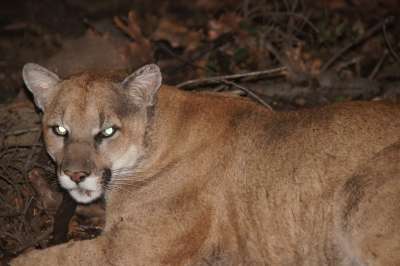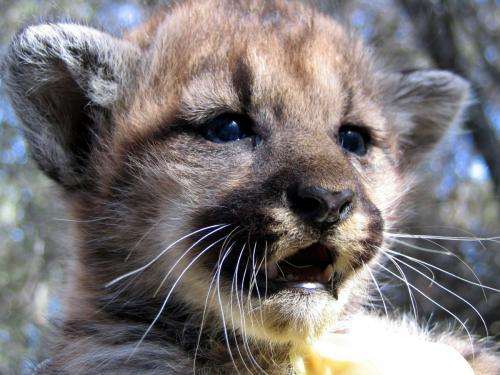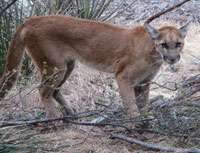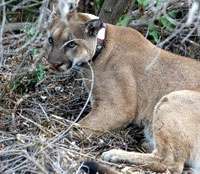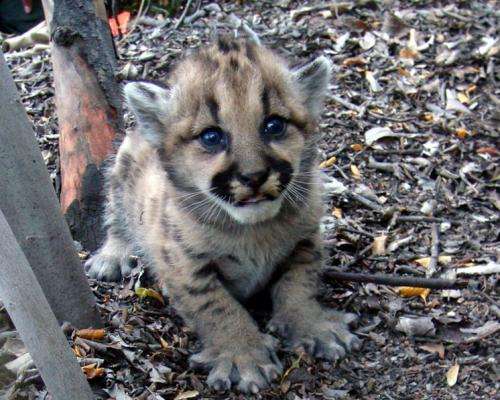P22, the mountain lion currently living in Griffith Park. Photo from the National Park Service.
The news is out that there's a mountain lion living in Griffith Park these days, but what you may not know is why he branched out from his home in the west Santa Monica Mountains. Competition there is fierce—and, according to the family tree traced out by a UCLA lab, it's also a bit of a soap opera up there.
At UCLA, forensic researchers test blood and saliva samples, compare bite marks, and use claw swabs to find traces of DNA. They're in the unusual field of wildlife forensics with the ability to determine which mountain lion killed another, who fathered the latest litter of kittens, and whether gene pools can cross freeway boundaries. The Robert Wayne Lab in the Division of Life Sciences takes the lead in collaborating with agencies like the National Park Service (NPS), with several other UCLA labs lending support.
"It's very much like animal CSI," said one UCLA researcher who studies the mountain lions.
UCLA scientists test DNA samples to help the park service learn more about mountain lions, but in the process, they also revealed a web of rivalry, slaughter and incest. Less sensational but equally dramatic are new insights about when the mothers teach their kittens about local terrain, what age the cubs leave their mother, and the quick return most mountain lions make to the hills after getting their first peek at an urban area. They're focused on learning how encroaching urban boundaries affect the population.
The park service's mountain lion project began in 2002, when they tagged puma No. 1, or P1, the dominant mountain lion at the time. When they found a mother mountain lion and her four kittens, UCLA's DNA analysis identified P1 as the father. They are solitary creatures, so it's unclear whether P1 would have recognized the mother or the kittens a year later when park service biologists found the female's body, and UCLA's DNA evidence showed P1 had killed her. The four almost-grown cubs had scattered, but P1 later ran into two of them and killed them off, likely seeing them as competition. P1 eventually mated with his own daughter, according to DNA analysis of her litter. The fourth kitten died in a fight with another puma. UCLA's DNA analysis showed the killer was new to the NPS, who succeeded in collaring the male once they knew to look for him—but then he too died when a car hit him.
These deaths are a common story for the big cats who live in the Santa Monica Mountains, UCLA researchers explain. Hemmed in to the north by the 101 freeway, males have few options when they're old enough to need their own territory, and the competition for land, mates and meals means the most common cause of death for local pumas is a fellow mountain lion. Researchers believe that's why P22, the mountain lion now living in Griffith Park, risked crossing freeways to get there. In the last two years alone, drivers have accidently killed at least two pumas trying to cross the 405 freeway in the Sepulveda pass.
The small population leads to inbreeding as well. UCLA's DNA tests sketched out the tangled family tree, showing that P1 and his daughter have a granddaughter who also mated with her father: the new king of the mountains, P12.
"We collaborate with the park service to look at the effect of urbanization on wildlife," said John Pollinger, who works in the Wayne Lab and is the director of UCLA's Conservation Genetics Resource Center, part of UCLA's Institute of the Environment and Sustainability. "Our main contributions are genetic testing and analysis to identify individuals, their relation to each other and their genetic fitness—for example, whether they're inbreeding—and we relate that back to what we already understand about mountain lions."
P8 as a kitten, before his father killed his mother. Click to enlarge. Photo courtesy of UrbanCarnivores.com
The labs also study many other animals, including mammals like coyotes, bobcats, deer, foxes and wolves, but also birds, fish, lizards, frogs and other creatures for state and federal agencies. For the mountain lion project, wildlife biologists with the National Park Service's Santa Monica Mountains National Recreation Area send samples to UCLA's Wayne Lab. At UCLA, the Wayne Lab, the Conservation Genetics Resource Center, the La Kretz Center for California Conservation Science, and the medical school's Genotyping and Sequencing Core all collaborate, uniting resources from the Department of Ecology and Evolutionary Biology, the Institute of the Environment and Sustainability and the David Geffen School of Medicine.
Thanks to the collaboration, events like P22's arrival in Griffith Park or the appearance of a mountain lion in downtown Santa Monica seem less random and more like part of the larger story. UCLA's DNA testing helped reveal more about the puma ultimately shot by Santa Monica police. He was the son of P12, currently the region's dominant male. He turned about to be about 2 years old, the age when mountain lions begin looking for their own territory. The park service has since worked with Santa Monica police and offers their services to other agencies to remind them of a unique local resource at their disposal: the park service's puma biologists, who have the field expertise to safely capture and relocate mountain lions like the one in Santa Monica.
Tangled family tree: The mountain lion known as P13, whose father is her grandfather, and whose "husband" is her "son-in-law." Photo: National Park Service
"You can imagine that this young male was really looking for places where he wouldn't bump into this big male that was dominating the area," said Professor Robert Wayne, a UCLA molecular geneticist and head of the Wayne Lab. "That's probably why it walked so far."
By tracking GPS data from tagged animals' collars, scientists know that pumas are usually more hesitant about entering urban areas and carefully avoid people, Pollinger said. GPS data showed one mountain lion "came down once and almost made it to the beach, saw all that urbanization, hightailed it back into the mountains and never came back." Likewise, the Griffith Park mountain lion has been captured by wildlife cameras and GPS from his tracking collar, but there have been no reported sightings, Pollinger said.
In one incident that seems to illustrate how far mountain lions will go to avoid people, two cats left a "crime scene" but no body. In 2009, early-morning tennis players arrived on a court in Agoura Hills to find a gruesome tableau: P1's tracking collar lay on the concrete, next to a pool of blood and some claw sheaths.
P12, the current dominant mountain lion. Photo: National Park Service.
"It was some kind of epic battle," Pollinger recalled. "And obviously, P1 had been there, because his collar had been pulled off."
"And getting those collars off is pretty impressive," noted Laurel Serieys, a UCLA Ph.D. candidate studying how urbanization affects wildlife in the Santa Monica Mountains. Her website details findings on all the mountain lions.
Like a CSI team responding to a crime scene, the National Park Service collected samples of blood, fur and claws from the tennis court and sent them to UCLA. DNA showed P1 had tangled with a puma who hasn't been identified—and who has never been found. Neither has P1.
Hearing about the deaths of the animals they study can be emotional, the researchers said, but some cases are worse than others.
"There's a difference between humans killing the animals, and animals killing each other," Serieys said. "One of those is biology. We're trained as field biologists, and we know that's nature and we shouldn't feel bad for that. We respect the predators."
P18 as a kitten, who later died trying to cross the 405. Click to enlarge. Photo: National Park Service.
However, death from human interaction is another story. There's the case of a puma whose decapitated body showed proof of poaching. Two others died from rodent poison. And the mountain lion who ventured into Santa Monica was shot by police out of concern for public safety. Those cases feel different.
"With the Santa Monica mountain lion, I feel bad, because that seems like it could have gone differently," Serieys said. "We do get invested in these animals, so when they die from human interaction, that's disheartening."
It's a risk the researchers take in studying the solitary species so close to a city. Fortunately, though mountain lions are a protected species, they are not endangered, and outside the freeway boundaries that hem in the Santa Monica Mountains population, the national park service team has tagged mountain lions in the Simi Hills and the Santa Susana Mountains.
"One of the problems in the Santa Monica Mountains is that it's very hard for the mountain lions to disperse, so there's a lot more fratricide and patricide, and at least two confirmed instances of inbreeding," Pollinger said. "At the same time, we don't know to what extent this behavior occurs in larger habitats. This is one of the first studies of mountain lions with this level of detail, and the park service has probably caught less than half of the animals in this habitat over the years."
They'll continue to watch and learn. The group is interested to see whether P22, alone in Griffith Park, will risk going back into another puma's territory to find a mate, and they're continuing to study how the fragmentation of the animals' territory and urbanization affect the population.
"We're still learning," Serieys said. "There are so many questions we still want to answer."
Provided by University of California, Los Angeles
